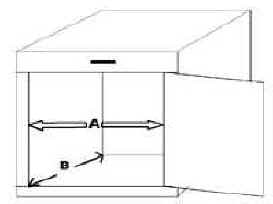
Clear opening width
We always refer to the clear cabinet
opening when talking about the shelf width not the actual finished wood box. The sliding shelf width dimension that
you must give us is the clear
cabinet opening (dimension A) at the height the shelf will be installed
(upper shelves do not usually need to clear the hinges).
The is usually the distance between the cabinet face
frames for upper shelves or frame to hinge for the lower pull out shelf. This dimension may be smaller due to any intrusions into the cabinet
opening or door placement or overlap. It is also important to check to make
sure the door opens far enough, at least 90 degrees. In some instances the door
may infringe on the opening more when it is fully open. This reduced dimension
is the best one to use. Always give us the clear cabinet opening when
ordering and we will adjust for the sliding hardware. Our pull out shelves are
custom made in 1/16" width increments. If you are installing an
upper level shelf there is no need to deduct for the hinges that are at the bottom of
the cabinet. The maximum width for our premium 2 3/8" tall pull out
shelves is for a 39"
cabinet opening. Remember that just because the bottom pull out shelf may need
to be smaller to clear a cabinet hinge it does not mean that the upper sliding
shelf has to be smaller as well. It is very common for the lower pull out shelf
to be smaller than the upper one.
Depth
Shelves that slide sliding shelves come in depths from as small as 9 3/4" to as
deep as 31 3/4" in
2" increments. We usually refer to the 21 3/4" deep shelf as 22", a 19 3/4"
is a 20" etc. A standard kitchen cabinet uses a 22" shelf and a standard
bathroom takes a 20" shelf. We recently added a 22 3/4" depth. We can go up to
36" deep but the cost per shelf can be over $190 per shelf. To measure for do it
yourself pull-out shelves simply check
the depth from the inside edge of the kitchen cabinet face frame (the back side
of the frame, not the front) to the back wall of the
cabinet (dimension B). Watch out for any protrusions such as pipes or electric wires or
outlets and adjust the size accordingly. Sometimes it is better to make a
pullout shelf that is not as wide but can then be full depth rather then a shelf that
is full width but 3" to 4" shorter. If you have a no shelf rear
socket (see
below) installation, and the cabinets are over 24" deep you will need to
special order deeper shelves on longer slides. Slides up to 31 1/2" long
are available.
Mounting style
There are three potential mounting arrangements for a sliding
shelf. Existing full shelf, a half shelf, and no existing shelf.
Base mount - 4 L brackets

A base mount is pretty much as it sounds. It is mounting to an
existing shelf or to the base of the cabinet. This is perhaps the easiest installation
available and also the strongest. The drawer slides will have four "L"
brackets attached and these "L" brackets are secured to your existing
shelf or cabinet floor. We use a specially made bracket that is designed for
this purpose. In framed cabinets this L brackets sits behind the face frame.
This brackets lifts the pull out shelf 5/8" above the surface it is mounted to.
If you have a frameless cabinet you may need to deduct for the L bracket, see
section below this paragraph. It is suggested that if the cabinet has
adjustable shelves and if the hardware for this is plastic, the hardware should be replace
with metal hardware. It is also necessary to secure the back of adjustable
shelves so that they can not tip up when the sliding shelf is extended. This is
accomplished simply by insert a couple of screws in the back or side walls with
the heads of the screws protruding enough to hold the shelf down and prevent tipping
when the slider is extended. If this is your set up specify full shelf on the
order page.
Frameless Base Mount
On frameless cabinets there
is no place for the L bracket that normally sits behind the cabinet face
frame. Because of this must deduct from the clear opening width. The L
brackets use 1/4" on each side. If you have a cabinet with no doors and
you want to base mount you will need to deduct 1/4" from each side to
allow for the L bracket. If you have a single door you will need to
deduct the 1/4" just one time and if you have double doors and hinges
protrude at least 1/4" into the opening you can order the clear opening
with no deductions

Half Shelf - 2 rear L brackets

Many cabinets come with an upper half depth shelf. This is a shelf that
is usually 9" to 12" deep at the back of the cabinet. You can install
a full depth shelf where you currently have the half depth shelf. You will use
the half shelf to secure the back part of the sliding shelf while the front of
the sliding shelf hardware will attach to the cabinet's face frames. The slides
will have two "L" brackets in the rear to attach to your half shelf. If there are
doors that protrude into the cabinet be sure to let us know the
difference between the cabinet face frame dimension and the clear cabinet
opening so we can include the proper spacers. In other words if you have a
15" opening and the shelf needs to be 14 7/8" because the door sticks
out 1/8", we can include a 1/8" spacer for you to put between the slide
and the cabinet face frame. This installation is very solid as long as the face
frames are a hardwood and not a particle board. We suggest reinforcing particle
board face frames with a hardwood piece placed vertically or installing a full
stationary shelf to mount the slider to. Make sure the half shelf is secure so
that it will not tip up when the sliding shelf is extended. See full shelf
section for tip on screws in the back wall. Half shelf installation will not
work easily with Blum full extension slides but it is fine with the ball bearing
full extension. The front of slide cannot attach to face
frame and will have to be built out from the sidewall of the cabinet to use the
half shelf mount. The same rules for frameless cabinets half shelf apply as they do for the
base mount regarding deduction for the L brackets

What if there is no existing shelf?
Just as it sounds the no shelf installation is for locations
where you want to install a Pull Out Shelf and there is no existing shelf. There are two types of no shelf installations. The first is with rear
mount sockets.
Rear Mount
Plastic sockets are
mounted to the end of the sliding hardware and are attached to the cabinet's back
wall. The front of the slide is attached to the cabinet face frame as with the
half shelf installation.
Important! Rear mount sockets will not work with
Blum full
extension slides The ball bearing full extension slides with soft close
do have a rear mount option available

Frameless rear mount

Side Mount

The second method of installing with no shelf is to
side mount. Spacers are used to attach the slides directly to the cabinet
sidewalls. The sidewalls must be thick enough so that the screws do not pop out
to the outside. If you are installing a series of shelves in one cabinet it may
be better to cut a piece of wood the same thickness as the side to build it out
as needed. If
this wood is mounted vertically from the base of the cabinet up the installation
can be very sturdy and support higher weight items such as canned food in a pantry. The same requirements for measuring apply for the no
shelf install as they do to the half shelf installation. Make sure to order the
spacers that you need when placing your order.
Frameless side mount

Slide Type
We offer three types of slides for our pull out shelves. The
standard slides are 3/4 extension and we also offer an upgrade full extension
ball bearing slides with soft close. The standard 3/4 extension slides
work great for most installations. For a regular kitchen cabinet a 3/4 extension
slides puts items that are in the back of the cabinet with the shelf closed, up
to where the front items were after the shelf is extended. In other words 3/4
extension slides make the back of your kitchen cabinet accessible. Full
extension slides do have their place. If you have a pantry and want to be able
to access the back items easily the full extension slides will do that for you
and many customers like the soft close feature as well
Looking for a do it yourself home improvement project to make
your life easier? Here is what you need to know to do-it-yourself install our custom made pull
out kitchen shelves. There are four ways to mount Shelves That Slide into your
cabinet. The first and most common is mounting on an existing full
size shelf or cabinet base. The second is mounting to an existing half
shelf that is 6" - 12" deep. The third is to mount to the rear
wall with sockets. The forth method is mount to the cabinet side
walls. All of these installation methods have similarities. We will cover
the basic steps first, then you can go on to the specifics for your method of
installation.
Use the shelf
The number one tip is to let the shelf be your tool for setting
the slides. There are points in every method of installation that will be
easiest to accomplish when you use the shelf as your placement guide. The drawer
slides that we use have a control side and a free side. The right side slides
are the control side, the track that the wheel rolls in is a captive one. The
metal is bent
around the wheel and the wheel will only track in that groove. The left side
slide is the free side that allows for adjustment of the assembly. For this
reason it is very important to pay attention to the left side slide. Any
problems with slide alignment will be evident here, the right side will align
itself.
Base mount installation
The easiest and usually strongest method of installing Shelves
that Slide is when you are mounting onto a full depth existing shelf or the
cabinet base. The first thing you need to consider is the existing shelf
permanent or is it adjustable. If it is a permanent shelf you can go straight to
installing the slides. If it is adjustable
you need to look at two things. The first is what are the clips or pins that are
holding it up made of? If they are plastic you need to replace them with metal
clips or pins. The front mounting of the shelf will be subjected to twice the
weight it is now exposed to when you extend a loaded shelf. The second
consideration goes right along with the first in that when the loaded shelf is
extended it will want to lift up in the back. This is easily remedied by placing a
couple of screws in either the back or the side walls (which ever is thicker,
but don't go through to an exposed wall) just above the existing shelf and leave
the head sticking out far enough to hold the screw down.
For a full shelf installation you should have two "L"
shaped brackets on each cabinet slide. The wheeled end of the cabinet part of
the slide is
the front. Set the slides onto the existing shelf or cabinet base at the
approximate width of the sliding shelf. Engage the shelf slides into the cabinet
slides by setting the wheeled end of the shelf slide over the wheeled end of the
cabinet slide. The most important side to get in place is the right side. You
can always slip the left side into place after getting the right side in properly.
Insert the shelf fully into the cabinet and align the front of the shelf to be
square with the cabinet front and have the proper set back. The proper set back depends on your cabinet
depth but it is usually about 1/2" to 3/4" back from the inside edge
of the cabinet face frame. Get your screwdriver ready! When you have the shelf
adjusted press down slightly and slide the shelf forward just far enough to
expose the rear brackets. Insert a screw in one of the slots in the right rear
bracket. Use the hole that goes side to side so you can adjust it latter, tighten moderately. Now slide the shelf back into place and check
the alignment. When it is adjusted properly slide the shelf out again to expose
the rear bracket and place a screw in the opposite side slotted hole in a slot
that goes from left to right and tighten moderately. Again slide the shelf in
and check alignment. If all is well you can carefully slide of the shelf without
disturbing the position of the front brackets. This may take a couple of tries.
Install screws in the front brackets the same as you did for the rear brackets.
Insert the shelf again and check alignment. Remember to pay careful attention to
the left side slide if the gap is too large in the rear the shelf will roll
great but as soon as you add weight you will get a bump when you slide it out. After you get everything aligned you can remove the shelf
and install a screw in the center hole of the bracket to lock it in place, two
screws per bracket is all that is needed.
Congratulations your shelf is done!!! Well almost, see plastic
thing.
The second method of installing sliding shelves is also the
second best and the second easiest. You will need a small level, preferably one
with a magnetic strip on one side. Check the existing shelf to make sure it is
secure and can not lift up. Also check to make sure the hardware that supports
the existing shelf is metal. If you have plastic hardware and plan on loading
more than lightweight items into the shelf you will have to replace the hardware
with metal. The slides for your half shelf installation will have one metal
"L" shaped bracket mounted toward the rear. The end with the wheels is
the front! If you have brackets in the rear and front, the front ones will not
be needed and should be removed. Set the rear bracket on the existing shelf and
place the front edge of the slide against the cabinet face frame, back about
3/16" from the front. Place your level on the slide and level it. When you
have the slide level mark the location of the front hole in the slide. You can
then measure the height and make a corresponding mark on the other side face
frame. It is best to drill a small pilot hole to prevent splitting, before screwing
the slide in place. After you have the front of the slides attached you can set
the shelf in place by lifting the wheels on the rear of the shelf slides over
the wheels on the front of the cabinet slides. Pay careful attention to the
right side slide. Insert the shelf all the way into the cabinet and align
the shelf to be square with the cabinet front. If there is too much space
between the cabinet face frames you will need to insert spacers or washers to
build out. You can order spacers from us in 1/8", 3/8", and 1/2"
sizes. You may also be able to find something similar in a local hardware store.
Get your screwdriver ready! Check the alignment of the left side slide and when
it is properly aligned press down slightly on the shelf and extend it far enough
to see the rear bracket. Place a screw in one of the slotted holes and tighten
moderately. Reinsert the shelf and check slide alignment. When alignment is
correct repeat the process of extending the shelf and insert a screw in the
other side's bracket. Again insert the shelf and adjust as needed. When
everything is aligned extend the shelf again and place a screw in the center
hole of the bracket to lock it in place. Congratulations your shelf is done!!!
Well almost, see plastic thing. Half
Shelf installations will not work with the Blum full extension slides but are
fine for the ball bearing slides
Rear mount sockets are a great alternative mounting for shelves
where there will not be much weight. They are perfect for adding a shelf in a
bathroom cabinet. The main limitation is if they are loaded with a lot of weight
they tend to only be good for a year or two before they succumb to the stress.
The first step is to determine the height that you want the shelf. Make a mark
on both cabinet face frames for the bottom of the shelf. Insert the cabinet
slides partially into the plastic sockets (you must have specified a rear socket
installation when ordering) note the brackets are different for left and right
sides. Attach the front end of the slides (the end with the wheels) to the
cabinet face frame where you marked. You will need to push the slide slightly
against the back wall of the cabinet to get the socket seated to the needed
depth. Install the shelf by lifting the rear end of the shelf slides (the end
with the wheels) over the wheels on the front of the cabinet slides. Slide the
shelf in completely and align it to be square with the front of the cabinet. Now
comes the fun part. Make a line on the back wall to mark the position of each
slide for the horizontal placement. You can now remove the shelf and place a
level on the cabinet slide. Align the slide with the previous line that you made
and level the height. Now you can either install one screw in the socket or mark
another line for the vertical position. Repeat this process for the other side
and after you have one screw in each socket reinstall the shelf and check for
proper operation. Once you have the shelf adjusted, install at least one more
screw in each socket. If you are having trouble getting the shelf to slide
smoothly make sure the slides are parallel to each other and not twisted.
Congratulations your shelf is done!!! Well almost, see plastic
thing. Rear mount sockets will not work with full extension
slides. Also they will not work with shelves deeper than 21 3/4" unless
longer slides are used.
When you need more weight capacity than the rear socket method
can provide and you either don't have or don't want full or half shelves in your
cabinet, the answer is side mounting. We can provide spacers to install the
cabinet slides to the cabinet side walls. The problem is the cabinet side walls
are usually not more than 1/2" thick and there is about 1" of space or
more that needs to be spaced out. Leverage will lead to this being a weak
installation. However if you can install vertical strips of wood on both sides
(two on each side, one near the front and the other near the back) that provide
the proper filling to match the space behind the cabinet face frame, a side
mount installation can be the strongest and most space efficient installation.
It is best to use a piece of wood the same thickness as the space behind the
face frame that runs from the bottom of the cabinet to above the height that you
want the shelf installed. You can glue and screw this piece of wood in place to
make a secure attachment. After the wood is installed you can measure up and
make a mark where you want the slides installed. Simple screw the slides in
where marked and you should be able to install the sliding shelf. Just lift the
rear end of the shelf slides (the end with the wheel) over the wheels on the
front end of the cabinet slides. Insert the shelf fully and check for alignment
paying careful attention to the left side alignment, adjust as needed.
Congratulations your shelf is done!!! Well almost, see plastic
thing.
Finally we come to that white plastic thing. That thing is a
door protector. There is one door protector per shelf included. If you have a
cabinet with two doors closing on one shelf (a door on both the left and right
side with no center divider) you will need two door protectors per shelf. Please
request the extra door protectors under special instructions. No door protectors
are needed for the economy shelves due to the extended front wood trim.
The door protector is mounted to the side of the shelf. The purpose of the door protector is of course to protect the door. The plastic
sticks out about 1/16" more than the drawer slide to keep you from
scratching the door in case it is not opened fully before sliding out the shelf.
Just screw the door protector to the side of the shelf (one screw). Watch for
hinge clearance and if the door has a recessed panel make sure you mount the
door protector as low as possible. The door protectors will not work on
standard height shelves with full extension slides. Fortunately the front of the
full extension slides is rounder than the 3/4 extension so the pullouts do not
need them as badly.
Please note: The actual
size of the wood box is 1" less than the size of the clear cabinet
opening that you provide. This is to allow for the sliding shelves
slides which use 1/2" on each side and must pass through the cabinet
opening. We tell you that only so that when you receive the shelf you do
not think we made an error. Do not adjust your width thinking that
somehow this inch can can sit behind the frame because if you do your
shelf will not fit!
Disclaimer
This page is offered as a guide for installing a pull out shelf and it is not intended to offer
every detail for every possible installation. It is expected that the home
improvement
do-it-yourselfer has sufficient knowledge as to judge the soundness of their
installation of kitchen and bathroom shelves.
Because it always helps to have another
viewpoint on home improvement and shelving systems installations
Here are some installation instructions
from a few of our customers
My assembly instructions follow. I had a full non-adjustable bottom shelf in
my cabinet, so I only wrote the instructions for this option.
FULL SHELF INSTALLATION
The number one tip is to let the installed right side cabinet guide
be the control for installing the left side cabinet guide.
The right side sliding shelf slide has a bent edge around the
wheel track and the wheel on the slide is to the rear. Assemble the right cabinet
guide with its wheel in front to the right sliding shelf slide.
Place this assembly onto your cabinet shelf and place it so the back of the
sliding shelf touches the front of your cabinet back. The shelf is centered on
the door opening. Now slide the left side cabinet guide with its wheel to
the front under the left sliding shelf slide (no bent over track edge).
You are now ready to set measurements for proper assembly.
First check for set back dimension. Move the shelf assembly forward to within
½" to ¾" from the back inside of the face frame. It should be
centered on the available opening and squared to the front of the cabinet back.
Get your screwdriver and supplied screws. All screws are to be lightly hand
tightened until final alignment is accomplished. Lightly push down on the right
side of the shelf as you move it towards you to expose the rear bracket on the
right cabinet guide. Maintaining the above alignment, drive a screw
through the rear front to back slotted hole in the exposed rear bracket.
While still maintaining alignment install a screw into the front left to
right slotted hole of the same bracket. Remove the shelf and the left
side cabinet guide leaving the screwed in place right side cabinet
guide. This will expose the front bracket on the right cabinet guide and
once again check square to the front of the cabinet back and install two screws
just as was done to the right rear bracket.
Next step is to install the left side cabinet guide. While holding the
left side cabinet guide against the cabinet shelf bottom and
approximately a shelf width left of the already installed right cabinet guide,
reinstall the shelf onto the attached right side cabinet guide and onto
the left side cabinet guide. Check your alignment and square. Install two
screws into each bracket (front and back) on the left side using the same method
as used on the right side cabinet guide.
Reinstall the shelf into the right side cabinet guide and onto the
left side cabinet guide. Move the shelf back and forth and if it binds
adjust the left side cabinet guide to allow the shelf to move easily.
When you are satisfied everything is aligned and moving smoothly install and
tighten a screw into the center hole of each of the four brackets. Tighten all
other screws.
Congratulations your shelf is done!!!! Well almost, see the plastic thing.
PLASTIC THING
Finally we come to the white plastic bumper, which is utilized to prevent
damaging the inside surface of the door. This might occur when closing against a
partially protruding shelf or when the door is in the way of your pulling out a
shelf. The plastic bumper is mounted with one screw to the front of the shelf
closest to the door hinges. Watch for hinge clearance and if door has a recessed
panel make sure you mount the door protector bumper as low as possible. Included
with very wide shelves, two bumpers are supplied assuming the opening has two
doors per shelf.
This "honey do" project was a snap and I believe if you use my
ideas other neophyte installers will be as pleased as I am with your product and
its ease of installation.
Respectfully,
Harry S.
Oregon
Steve, the shelves arrived and are installed --
thanks!
I installed your drawers on movable shelves. I
read your installation instructions on your web site several times
through, just to make sure I would do the job right. Each time through,
though, I kept thinking to myself, there has to be an easier way than
sticking my head back into a cramped, poorly lit pantry, trying to
align, then screw down, these brackets.
Now, I'm no pro, but I've done my share of DIY
projects. There's a couple of things I can almost guarantee with a
project like this. First, there will be bloody knuckles. The second
thing, sometimes related to the first, is that there will be cursing.
So I'm reading your instructions, thinking, there are tight dark corners
in there, and drawer slides that need to be lined up perfectly (or at
least, close to perfect) -- there will be cursing for sure, and probably
bloody knuckles! Why, I'm thinking to myself, do I have to attach those
slides in place? Why can't I take these removable shelves out of the
pantry and fasten the slides in a nice, open, well-lighted space, where
there's plenty of room? All I have to do, I'm thinking, is get the
proper measurements, mark the shelves, and it should work.
I figured I'd try the first of the four shelves,
and if it worked, I'd finish the other three that way. If not, the
worst case scenario is that I have to turn the shelf upside down to
avoid misplaced screw holes, and start over, using your instructions.
I took some photos to document the process --
feel free to use them if you'd like. And, if these instructions make
sense, use them, too.
The "bare shelf" picture shows the removable
shelf -- pretty typical, laminated mdf. The only trick here is to make
sure you work with the laminated edge exposed - the back edge is bare
mdf, and you want that towards the back.
My shelves are 22 1/4" wide. I placed the
drawer, in the slides, on the shelf (see "drawer in brackets no screws"
picture) and measured. That width was 20 3/4". The difference is 1
1/2"; divided by two, that's 3/4" on each side. This approach will only
work, I suppose, if your placement (like mine) is symmetric, same
clearance on both sides. The front to back placement was simply a
matter of judgment, making sure there was enough clearance for the
pantry door.
I took my handy square, set the ruler gauge at
3/4", and marked a line on both sides, front and back, approximately
where the slide brackets would be. See photo, "measuring in from the
side". I did the same from the back edge of the shelf, with the proper
distance. On subsequent shelves, I knew the 3/4" was constant from the
sides, and for the back edge, I simply loosed the nut on the gauge,
adjusted the ruler, and used that.
Next, I screwed in the slides, one screw per
bracket, in the slots (not the center hole), so I would have "play" in
all directions, if needed. See photo, "one back screw." I inserted the
drawer, and tested it out, making sure it glided smoothly. When I was
happy (very, very little adjustment was needed), I pulled the drawer
slightly forward, and placed a screw in the center hole. I carefully
removed the drawer, tightened the screws in the front slots, and placed
the center screw. I tested the drawer again -- still glided smoothly.
I then placed the shelf in the pantry. See
photo, "Shelf in place." Once again, I placed the drawer in and tested,
making sure there was smooth glide and clearance. See photo, "Drawer in
place." Satisfied, I placed two screws into the back wall, as you
suggest on your site, to make sure the shelf doesn't tip forward when
the drawer is extended.
The first time worked like a charm. I was
pleased, so I decided to take the photos of the second shelf (the ones I
have attached). On the third, I thought I'd time myself, since I had
the process down. Using only a hand screw driver (no power tools), and
taking my time, no hurrying, the third shelf took 7 minutes, 17
seconds. I didn't time the fourth shelf, but I think it was faster than
the third.
And, as you can see from the last photo, no
bloody knuckles, and (you'll have to take my word) no cursing!
My wife and I love the shelves, and we will
definitely recommend them to all our friends!
Bert S. Braud
The Popham Law Firm
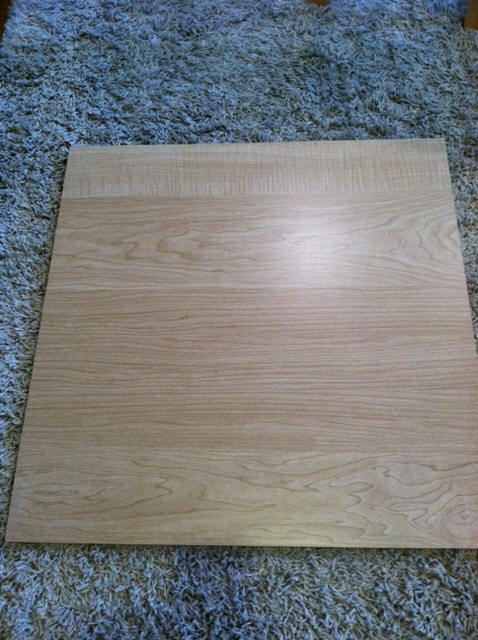
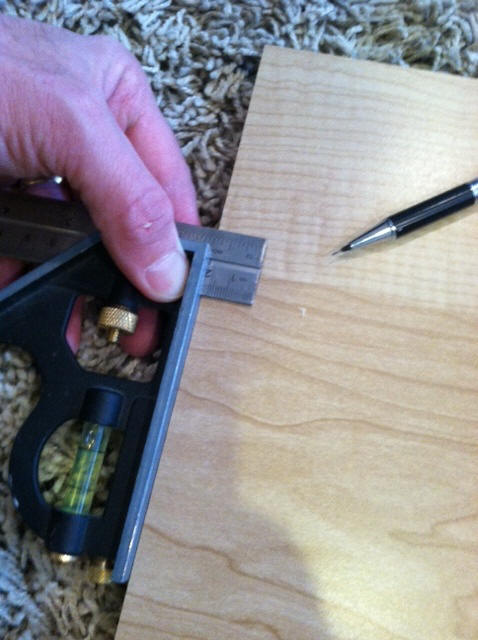
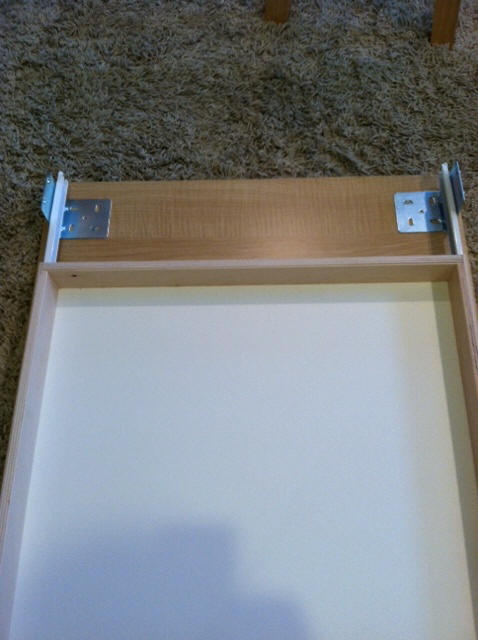

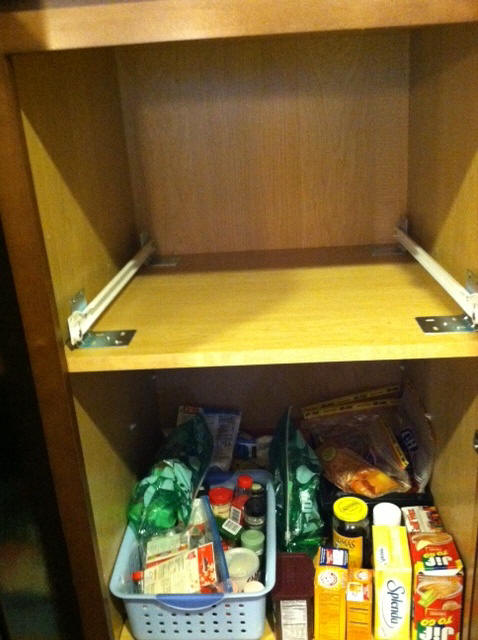
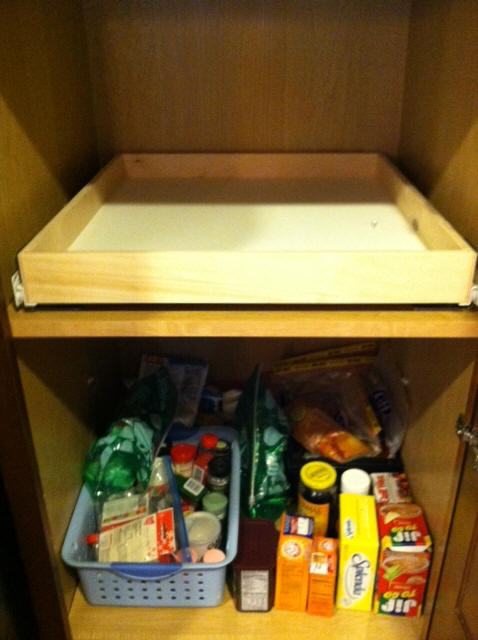
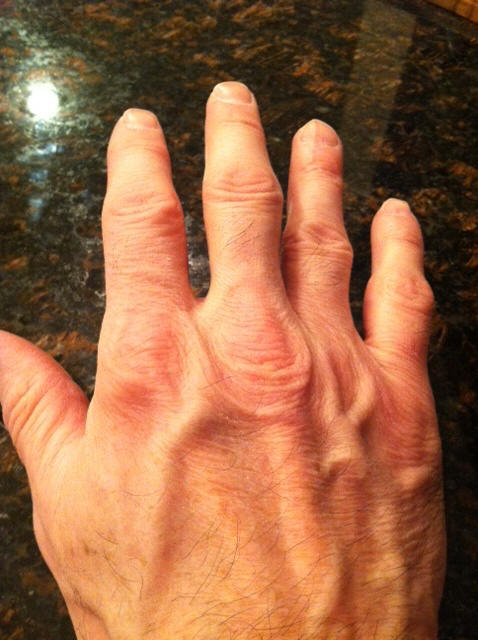
|